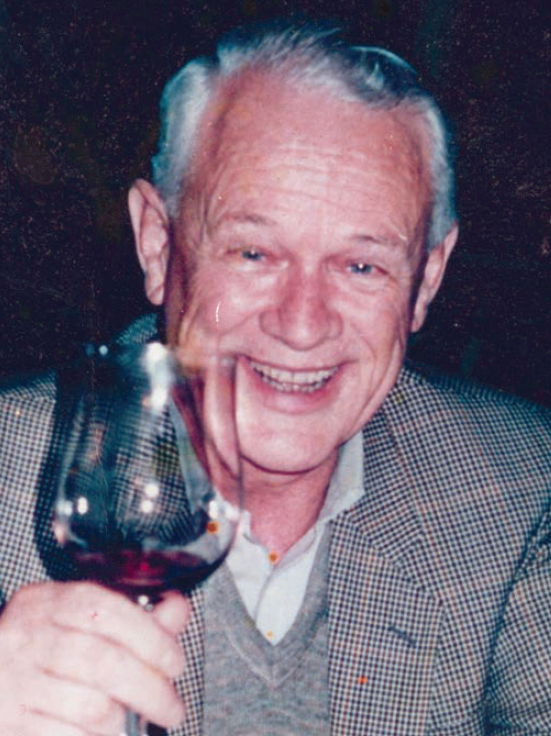
EMIL PFENDER
1925–2016
Elected in 1986
“For pioneering contributions to arc technology, plasma chemistry, and heat transfer, and for inspiration and international dissemination of knowledge.”
SUBMITTED BY THE NAE HOME SECRETARY
EMIL PFENDER died January 28, 2016, at age 90. He was a leading contributor to the fundamental science of thermal plasmas and their applications, especially in torch design optimization, plasma-sprayed coatings, and the synthesis of advanced materials. At the time of his death he was emeritus professor of mechanical engineering at the University of Minnesota.
He was born May 25, 1925, in Dietershausen, a small farming village in southern Germany. He earned his diploma in physics in 1953 and his doctorate in electrical engineering in 1959, both from the Technical University of Stuttgart, where he then became chief assistant and lecturer in the Institute for Gaseous Electronics. In 1961 he spent a year as a visiting scientist at the Plasma Physics Branch of the Air Force Research Laboratories at Wright Patterson Air Force Base near Dayton, Ohio.
In 1964 he was recruited by Ernst R.G. Eckert to direct the High Temperature Laboratory (now the High Temperature and Plasma Laboratory) in the Department of Mechanical Engineering at the University of Minnesota. He was hired as an associate professor and became a full professor in 1967. Under his leadership the HTL (HTPL) grew to become one of the most highly regarded plasma research laboratories in the world.
Pfender worked primarily in the area of thermal plasmas, with emphases on plasma heat transfer and plasma processing of materials. He conducted pioneering research on fluid dynamics and heat transfer under plasma conditions using direct current (DC) and radio frequency inductively coupled plasma sources, electrode phenomena, DC torch design for plasma spraying and cutting, plasma spraying to apply protective ceramic coatings to surfaces (for applications ranging from jet engine turbine blades to hip implants), plasma synthesis of ultrafine powders (later termed nanoparticles), modeling and diagnostics, and chemical vapor deposition. He was among the first to simulate dynamics of the arc in a DC plasma torch, using a three-dimensional, transient, local thermodynamic equilibrium mathematical model with a variational multiscale numerical approach. He also developed processes for using thermal plasmas to deposit thin films and coatings of diamond.
His 1967 publication, with Eckert, of “Advances in Plasma Heat Transfer” in Advances in Heat Transfer (Academic Press Inc.), became a fundamental and frequently cited reference in this area. In 1980, with Stanislav Vepřek of the University of Zürich, he cofounded the journal Plasma Chemistry and Plasma Processing and served for 25 years as its coeditor in chief. With Maher I. Boulos, of the University of Sherbrooke in Canada, and Pierre Fauchais, of the University of Limoges in France, Pfender coauthored volume 1 of the textbook Thermal Plasmas: Fundamentals and Applications (Plenum Press, 1994). This work remains a standard reference for researchers in the field.
In 1995 Pfender was the first recipient of the Plasma Chemistry Award, then given by the International Union of Pure and Applied Chemistry and subsequently by the International Plasma Chemistry Society after its founding in 2000. Given to a single individual once every 2 years, it is the society’s highest award and recognizes lifetime achievement in plasma chemistry. He was recognized as a fellow of the American Society of Mechanical Engineers in 1981, and received the Alexander von Humboldt Award of the German
government (1978) and a certificate of recognition from the National Aeronautics and Space Administration (1996).
He formally retired from the university in 2000, but as emeritus professor he remained up to the time of his death an active member of the graduate faculty in mechanical engineering, coadvising several PhD students and collaborating with Boulos and Fauchais on volume 2 of their textbook.
Emil Pfender and his wife Maja were married in 1954. Throughout their marriage, rarely a week went by without their hosting students or colleagues for a gourmet meal. Sometimes the menu included wild venison, pheasant, or moose, a result of Pfender’s hunting passion. He also enjoyed forestry and was a connoisseur of fine wine.
In addition to Maja, he is survived by sons Roland and Norbert, daughter Corinne, six grandchildren, and two great-grandchildren.
He was known to his friends and colleagues as a true gentleman, unfailingly gracious, humble, and generous.




